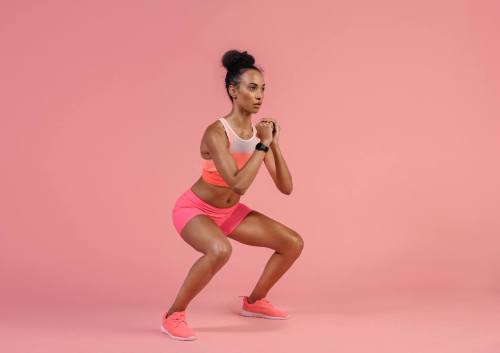This 3-move, total-body workout packs in a full sweat sesh in a matter of minutes
This 3-move full body at home workout that you can nail whether you have access to a gym or just a mat rolled out in front of your computer.

First things first, let’s get one thing straight: You can’t target all of your muscles evenly in every single movement you perform—otherwise you’d be doing burpees all day, every day. “There’s no way to evenly use all muscle groups throughout any strength exercise since the purpose of strength exercise is to isolate one certain area,” explains New York Sports Club Lab master instructor Bianca Vesco explains. “Specifically, if you’re focusing on smaller muscle groups, you have to use a light enough weight for that area, so that the stronger muscles surrounding it don’t take over.”
Just because you can’t target everything in one fell swoop doesn’t mean it’s impossible to train your body to use all your muscles though. The trick is to 1) be mindful and present in your body, and 2) commit a killer full-body workout to memory.
According to Y7 studio instructor Caitlyn Casson, total body training starts with a simple shift in awareness. “Often we work out to target specific areas of the body: the booty, the biceps, the abs,” she starts. “But, let’s remember that the body is a fully connected structure, each piece connects to something else.” With this small shift in awareness, Casson explains that we can keep all parts of the body engaged and present in every movement. “You’re doing squats for your booty? Can you also engage your abs and back muscles to support the motion of the squat?” she asks. “Or maybe you hold plank for your abs, but notice that the chest, shoulder blades, quads, and inner thighs are also firing up.” In the end, she lives and breathes the mantra that: Total presence equals total body.
That said, when designing full-body workouts, Vesco says that you want to hit as many muscle groups as possible, so think about using compound movements that will spike your heart rate and incorporate several joints as you’re moving. Luckily for you (and us, TBH), we spoke with two industry pros to teach us the know-how for both of these key tips. Check out their thoughts, below.
Squat-to-press
Target your upper body and lower body—quads, glutes, and shoulders—with this easy-to-execute exercise. To perform the movement, grab a set of dumbbells and keep them at your shoulders as you sit into a squat. As you stand up from your squat, add a shoulder press at the top.
Reverse lunge to bicep curl
Sculpt your quads, glutes, and biceps with this lower-upper combo. Vesco says to hold a dumbbell in each hand as you step back into your lunge, bicep curl as you bring your leg forward to neutral standing position.
Lateral lunge to dumbbell fly
Get excited: This move tones your inner and outer leg (abductors, adductors, gluteus medius), lats, and rotator cuffs. Grab a pair of dumbbells and alternate from leg-to-leg for side lunges. “As you step out to the side, your weights will frame the foot that moves,” Vesco explains. “As you come back through center, add your dumbbell fly and step right into the other side.”
For a quick and effective burner, Vesco recommends incorporating these exercises into a circuit of three sets of 12 reps each. “Notice a pattern here?” she asks. “Lower body exercises paired with upper body exercises are sure to keep your heart rate up and your body moving.” These compound movements allow you to work more than one part of your body so that you can get in a full workout no matter how much time is on your hands.
Speaking of training your body, you might want to work on stretches to help you sink deeper into squats and lunges while you’re at it. Or perhaps you want to sculpt your bod with kettlebells, instead of dumbbells. Either way, we’ve got you covered.
Sign Up for Our Daily Newsletter
Get all the latest in wellness, trends, food, fitness, beauty, and more delivered right to your inbox.
Got it, you've been added to our email list.










